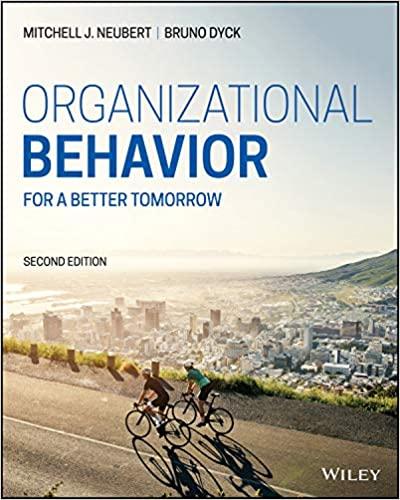Rick Douglas is the sales manager for the industrial products division of Norton Manufacturing. He has held
Question:
Rick Douglas is the sales manager for the industrial products division of Norton Manufacturing. He has held this position for nearly two years. Most orders from clients are for the standard version of the division’s products, but customized versions are becoming increasingly important as a source of profits. A few months ago, one of Rick’s sales representatives obtained an order from a new client for some customized products. Now the client wants to speed up the delivery of the order by three weeks. It is a very lucrative order, and the client will pay extra for early delivery. Rick’s sales representative has asked him to expedite the order. Rick knows that two things are necessary to get faster delivery to the customer. First, Rick must influence Carl Miller, the product design manager, to finish developing the specifications and testing the samples. Carl needs to run some more tests on the products, but he could be ready for production next week. Rick has a friendly working relationship with Carl, and they occasionally play golf together. When he first came to Norton, Rick spent several months working in product design as part of the company’s management training program. He understands the technical specifications of the products and works closely with Carl in determining how to satisfy the specialized needs of industrial clients. The other thing Rick must do to expedite the order is influence Ken Williams, the plant manager, to change his production schedule. Ken has been trying to complete work on a large production run for one of the company’s regular products.
Interrupting this work to shift production to Rick’s order would cause delays and make more work for Ken than if he just finished the current run first. The production equipment must be adjusted for Rick’s customized products, and then readjusted afterward for the regular products. In addition, special materials must be obtained quickly to make the customized items. Ken is loyal to the company, but he has complained that the industrial salespeople seem to favor the customized products with lots of “bells and whistles” over the basic products that have kept the company going through the years. Ken is still a little distrustful of people in sales due to some conflicts he had with the person who formerly held Rick’s position. Rick is confident that the profits from his special order would more than compensate the company for any delays or costs of changing production schedules. Moreover, if this client is pleased with the product quality and customer service on their initial order, the client could become one of the division’s most important clients in future years. The new business would justify to purchase some new equipment that Ken wants for the production department. Ken requested the new equipment last year, but the funds were not approved by top management. Source: Yukl, G. (1998). Leadership in organizations. (4th ed.) Upper Saddle River, NJ: Prentice Hall. DISCUSSION STARTER Trust Bank Activity You can think of each relationship in your work environment as having a “Trust Bank,” whose balance is the sum of all your relational deposits (that is, behaviors that build trust) and withdrawals (behaviors that reduce trust). Create a list of your recent deposits and withdrawals. Be specific about the behavior, but don’t name names.
After everyone has written down his or her ideas, have all group members list examples of their deposits and withdrawals. Listen to the ideas of others and add them to your list. This is the critical step in the process. After all, to be a trust builder you have to be interested in what others believe builds trust. You can think of each relationship in your work environment as having a “Trust Bank,” the balance of which is the sum of all your relational deposits (that is, behaviors that build trust) and withdrawals (behaviors that reduce trust). Create a list of your recent deposits and withdrawals. Be specific about the behaviors, but don’t name names.
1. Describe the characteristics of the relationships in the case.
2. Which influence tactics might be most useful in Rick’s negotiating with Carl and which ones in negotiating with Ken?
Step by Step Answer:

Organizational Behavior For A Better Tomorrow
ISBN: 9781119702856
2nd Edition
Authors: Bruno Dyck, Mitchell J. Neubert





